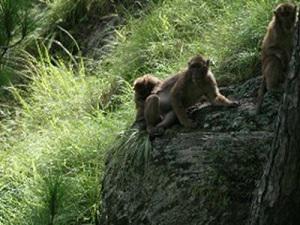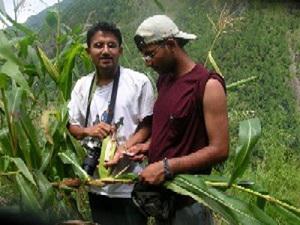Ganga Ram Regmi
Other projects
25 Jun 2009
Community Outreach and Conservation Education Programme for the Conservation of Assamese Macaques in Langtang National Park, Nepal
16 Jan 2012
Mapping Crop-Raiding Hotspots and Predicting Actual Crop-Raiding Risk Using a Spatial (GIS) Model for Alleviating People-Primate Conflict in Nepal
The aims of the proposed project are to assess of the Assamese macaque population in Langtang National Park including population surveys, analysis of socio-ecological factors and site-specific conservation measures.

Juveniles of Assamese Macaque in study area.
Macaca, comprising 22 well-characterised species, represents the largest and one of the most ecologically and socially diverse of all the nonhuman primate genera. In Nepal, only two species of macaques have been reported; the Rhesus macaque (Macaca mulatta), and the Assamese macaque (Macaca assamensis) among which the later one is less explored nonhuman primate of Nepal. The Assamese macaque (Macaca assamensis) of Nepal is fully protected under government law. Its distribution is restricted to the Himalayan foothill regions of Nepal. The taxon is designated as threatened due to its restricted distribution of less than 22,000 km², an estimated area of occurrence of about 914km² with continuing decline in area, decreasing quality of habitat, and declining population.

Adult male Assamese Macaque in the study area.
Given its restricted extent of occurrence, increasing threats to the individuals and habitat, and decreasing numbers in fragmented patches, the Nepal Assamese population is categorized as Endangered after the CAMP workshop 2003. Likewise the National Parks and Wildlife Conservation Act of 1973 lists the Assamese macaque as a protected species of Nepal and appendix II of CITES. Of equal concern is the fact that these animals are considered as crop- raiding pest in Nepal and, as such, conflict between local people and the macaque is on the rise. This, in turn, presents an additional threat to the survival of the macaques. Given the decreases in natural habitat and population numbers along with increasing threats due to retaliation for crop raiding, there is critical need to evaluate the population status of Assamese macaque in Langtang National Park and help with generating solutions to deal effectively with the human – monkey conflict.

The aims of proposed study therefore will be to assess of the Assamese macaque population in Langtang National Park. This comprehensive project will include population surveys, analysis of socio-ecological factors and site-specific conservation measures and development of community outreach / participation programs. Outreach programs will be conducted for local school children and local farmers to help generate a sense of commitment to the conservation of the macaques in the area.